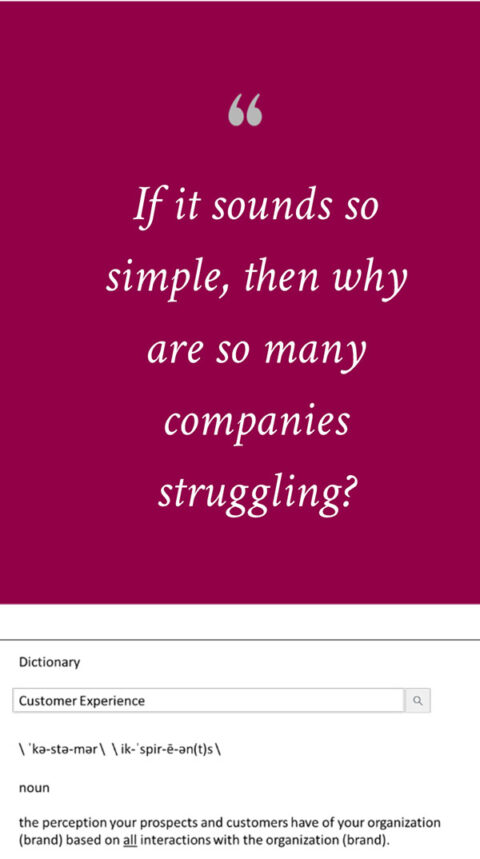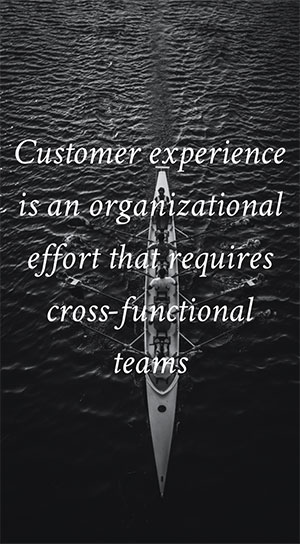I am often asked what I do for a living. I usually say that I am a customer experience and employee engagement consultant. This is immediately followed by: What does that mean? I explain that I help companies evaluate the experiences they deliver to their customers and then work with them to help improve those experiences. They instantly understand and proceed to tell me about a bad experience they have had, or about how so many companies really need help. If it sounds so simple, then why are so many companies struggling to deliver a consistently positive experience?
What does customer experience mean?
I asked eleven friends, who do not work in the customer experience field, to define the term “customer experience”. Three provided what they want an experience to be when they interact with companies. The others provided similar responses:

- The ultimate barometer of the success or failure of all the practices, protocols and training that a business puts into place
- How the customer feels from start to finish when dealing with a company or small business
- The experience a person has when dealing with a company
- The whole experience, what makes one want to use a particular company
- The experience from the customer’s perspective
- The customer service a company provides
- How people are treated when they contact a company with an issue
- The interaction of consumer wants and needs, their perception of delivery, and the understanding by the organization of what is important to the consumer and their efforts to successfully deliver those experiences
From my very unscientific research, two issues emerge – 1: people don’t follow instructions and, 2: while there are similarities, if these individuals worked at the same company, the nuances seen could impact decisions being made and the experience being delivered. Think about your company: if you asked employees to define the term “customer experience” what type of responses would you get?
Customer Experience itself is a very simple term for those of us that live and breathe it daily:

- Customer: The individuals or companies, whether they purchase or not, that interact with your organization (employees, communications, products and services)
- Experience: The perception of, or participation in, activities as a basis of knowledge
When combined…Customer Experience is the perception your prospects and customers have of your organization (brand) based on all interactions with the organization (brand). Perceptions can be formed in many ways beyond personal experiences and interactions – anecdotes from friends and colleagues, news, and social media.
Why wouldn’t a company want to ensure that their prospects and customers have a positive experience with their organization? I believe we are all in agreement that every company wants to deliver positive experiences. Note that I intentionally did not say good, great or exceptional experiences. Why? Simply because most people are looking for a positive experience – that is…help me get what I need and make it easy for me.
What makes customer experience so complex?
Having personally led or assisted on numerous customer experience initiatives across B2C, B2B and B2B2C companies, there are several main factors which have the potential to reduce the complexity of customer experience and increase the success for an organization to become more customer-centric.
CX as a strategic objective
CX initiatives are a change catalyst and, as such, CX needs to be a strategic objective tied to the overall corporate vision. Every department within the organization, either directly or indirectly, impacts the experience delivered to customers and plays a key role in the success of CX initiatives. Setting CX as a strategic objective signifies to the organization the commitment that management is willing to make.
Knowledgeable and empowered CX leader
The CX leader must take ownership and responsibility for the success of the program, and be empowered to influence strategy to impact the end-to-end customer journey. They must understand how the organization works together to deliver the customer experience and build relationships across departments. They must also understand the requirements to change an organization or have the ability to hire CX consultants to guide them.
Management alignment
Business leaders must be aligned around a common understanding of CX as well as having clear specific objectives and planned initiatives. All leaders must understand and accept their role in leading their teams to break down silos in support of the CX leader to drive cultural change. I know it is a cliché, but leaders must lead! They need to set an example by continuously communicating the strategic goals and tactical needs to make the CX program successful.
Communication plan
The CX plan should not be a secret. Develop a communications strategy to not only share the CX objective, but also the planned activities, the program’s progress, and how the program is being measured and evaluated. Share CX success stories, as well as lessons learned. Leaders must show support and communicate.
Governance program
Where would your organization be without policies and procedures? As mentioned earlier, everyone in the organization has a role in delivering your experience. CX governance is required to develop policies, apply consistent best practices, drive accountability throughout the organization by creating committees and assigning specific tasks and responsibilities to those committees. CX governance plays a key role in driving and supporting change across the organization.
Include and engage employees
Remember your employees deliver your experience – Bain & Company has demonstrated that companies with highly engaged employees grow revenues 2.5x as much as those with low employee engagement. A top-down & bottom-up approach is critical, including your employees in defining your CX vision, principles and behaviors. This requires more time early on, but you will create a program that the full organization can support.
Focus on Survey Scores and Business Impact
Many organizations focus on transactional scores and/or a relationship score (like NPS) to measure their CX success. While important, they are not enough – focusing only on scores will make CX be solely about the scores. CX measurement plans must include both CX scores and business outcomes. Ideally, the measurement should be a balanced scorecard approach that includes survey scores, drivers of CX, employee behaviors and business impact measures.

Wow, this does sound complex! However, it is no more complex than implementing a new technology platform, developing marketing strategies, developing and launching new products, or starting up a new company.
Any large initiative is complex, and yes CX is a large organizational-wide initiative. As such it requires strategic planning, resources, funding and commitment across the organization. CX is not quickly implemented and it does not have an immediate impact on the business – simply appointing a person to be “responsible” for CX with little to no budget, few resources, and no governance or leadership support is like climbing Everest without a Sherpa.

Customer experience is an organizational effort that requires cross-functional teams. The team needs to combine the skills and experiences across the customer journey of both experience creators (those delivering the experience) and experience enablers (those in supporting roles). Having representatives across many different disciplines ensures that you will create and deliver the best possible experiences.
In conclusion, CX is intertwined in every aspect of an organization and while this does make it complex, it is manageable by taking a disciplined change management approach. Whether your objectives are simply to identify and improve customer pain points or a full culture transformation, developing a strategy that includes alignment, governance, communications, employee engagement, and measurable outcomes is critical.